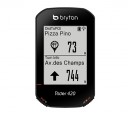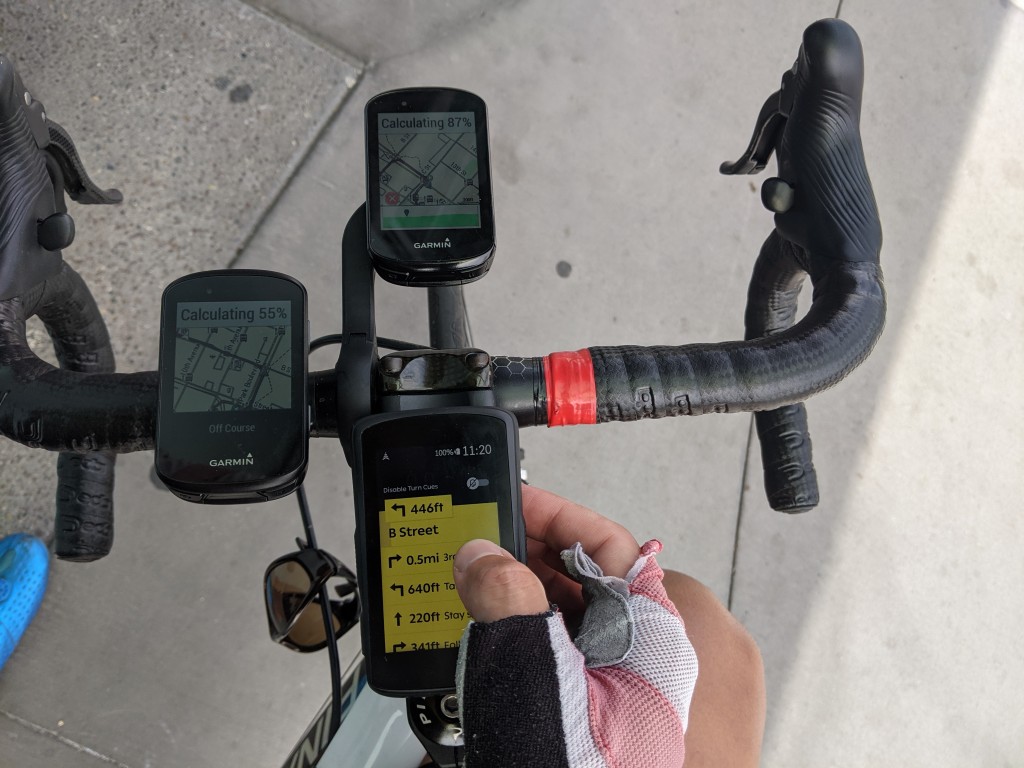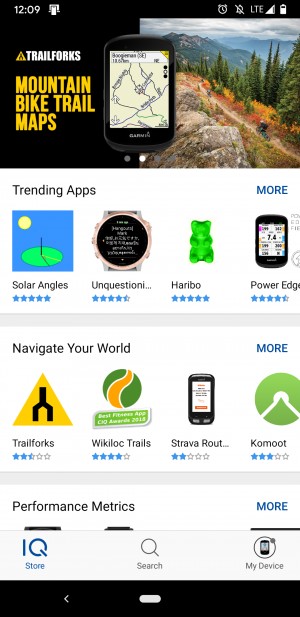Garmin Edge 530 Review
Our Verdict
Compare to Similar Products
 This Product
Garmin Edge 530 | |||||
|---|---|---|---|---|---|
| Awards | Best Balance of Ease of Use and Functionality | Best for Bikepacking and Touring | Best Bang for the Buck GPS Enabled Computer | Best Basic Computer | |
| Price | $199.99 at Amazon Compare at 2 sellers | $279.99 at Backcountry Compare at 2 sellers | $265.90 at Amazon Compare at 2 sellers | $160 List $99.95 at Amazon | $60 List |
Overall Score  |
|||||
| Star Rating | |||||
| Bottom Line | One of the best button-operated bike computers you can get your hands on | Easy to use and well designed device whose smaller screen and lack of activity profiles keeps it out of top spots | Excellent navigation and mapping with colorful screen that lacks workout planning and can be slow at times | You're trading user experience for price against unrefined performance | The ideal computer to get your basic riding data without fussing over the noise |
| Rating Categories | Garmin Edge 530 | Wahoo Fitness ELEMN... | Garmin Edge Explore 2 | Bryton Rider 420 | CatEye Quick |
| Ease of Use (30%) | |||||
| Ease of Setup (20%) | |||||
| Features (20%) | |||||
| Versatility (20%) | |||||
| Water Resistance (10%) | |||||
| Specs | Garmin Edge 530 | Wahoo Fitness ELEMN... | Garmin Edge Explore 2 | Bryton Rider 420 | CatEye Quick |
| GPS enabled | GPS, Glonass, and Galileo | GPS, GLONASS, BEIDOU Galileo, and QZSS | GPS, Glonass, and Galileo | GPS, Glonass, BDS, Galileo, QZSS | No |
| Cadence Sensor | ANT+ or Bluetooth | ANT+ or Bluetooth | ANT+ or Bluetooth | ANT+ or Bluetooth | No |
| Heart Rate Monitor | ANT+ or Bluetooth | ANT+ or Bluetooth | ANT+ or Bluetooth | ANT+ or Bluetooth | No |
| Power Meter | ANT+ | ANT+ or Bluetooth | ANT+ or Bluetooth | ANT+ | No |
| Smart Trainer | ANT+FE-C | ANT+FE-C | ANT+FE-C | ANT+FE-C | No |
| WiFi | Yes | Yes | Yes | No | No |
| Weight | 76g | 68g | 104g | 67g | 18g |
| Dimensions | 1.9" x 3.2" x 0.8" | 3.1" x 1.9" x .84" | 4.2" x 2.2" x 0.8" | 2" x 3.3" x 0.86" | 3.7" x 2.1" x 1.4" |
| Display Size | 2.6" | 2.2" | 3" | 2.3" | 1.25" x 1.25" |
| Battery Type | Re-chargable lithium ion | Re-chargable lithium ion | Re-chargable lithium ion | Lithium polymer | CR2032-Sensor, CR1616-Display |
| Battery Life | Up to 20 hours (claimed) | 15 hours (claimed) | Up to 16 hours (claimed) | Up to 35 hours (claimed) | 1+ years |
| Touchscreen? | No | No | Yes | No | No |
| Phone App | Garmin Connect | ELEMNT Companion | Garmin Connect | Bryton Active App | None |
| Accessory Interface ANT+, BTLE, BT. | Bluetooth, ANT+ | Bluetooth Smart, ANT+, WiFi | Bluetooth, ANT+ | Bluetooth, ANT+ | Proprietary Analog Wireless |
| Strava Segments | Yes | Yes | No | No | No |
| Text, Email, Call notifications | Yes | Yes | Yes | Yes | No |
| Navigation | Yes | Yes | Yes | Yes | No |
Our Analysis and Test Results
After spending weeks out on the road testing the Edge 530 alongside a handful of top bike computers and researching and tinkering with all of its functions, it's hard not to conclude that it's probably the best computer out there for non-touchscreens. It's a near copy of its fancy sibling, the Edge 830, but lacks a few core functions, and of course, it doesn't have a touchscreen. For dry, warm-weather folks, this is a sticking point, but if your bike life is spent wet or wearing thick, full-finger gloves, you won't get a ton of use out of a touchscreen anyway, so the buttons may actually be a selling point for you! We'll spend the rest of this review working through the 530's performance across our measures to help you figure out if it's indeed the right device for you.
Performance Comparison
Ease of Use
The successor to the Edge 520, the first thing you'll notice about the Edge 530 is its larger frame. The display is now the same size as the premium 830 model. In fact, they look nearly identical now, except that the 530 has 7 tactile buttons along its edges to fully operate the device while the 830 only has 3 for basic operation (start/stop, lap, power) along with its touchscreen. There are some trade-offs to consider here. Most of us are enamored with touchscreens, so it's a slight bummer that the 530 doesn't have one, but it makes using the device in the rain or with gloves a lot more practical. For those of us riding in sunny temperate places like SoCal, it's rarely wet and full-finger gloves only come out on the earliest of February mornings, and even then it's for about an hour.
Booting up the Edge 530 takes a good 20 seconds to get'er turned on and ready to accept commands. That's not bad. Most smartphones take a lot longer than that. It's the sort of thing where you get the process started as you're walking to the door and then you can hang on for a few more seconds to get your sensors woken up and paired and satellites acquired. If you're following a route or using a navigation feature, expect it to take just a wee bit longer to get itself sorted. It needs to find itself (not in a metaphysical sense) and start calculating routes, which took a little longer than we'd have hoped. The higher-end computers were about twice as fast in this task.
Battery life is about where you'd expect it to be. 20 hours is the stated battery life and that's about what we got across a handful of rides out in the wild while using heart rate, speed, cadence, and power meters. Adding features like phone notifications, navigation, and bright, constant display will obviously blow through the battery faster.
One of the best features of the Edge 530 is its connectivity. It uses all the major protocols to communicate: ANT+, Bluetooth, and WiFi. This means you have lots of options for sensors, downloads, and pairings. The Garmin Connect app is pretty helpful here too, enabling features like Live Track and Incident Detection, which will blast out a notification to your contacts if something's detected. The only downside we found was that the connection to your phone sometimes drops.
Ease of Setup
For existing Garmin users, setup will be a breeze because the physical accoutrements are the same and most digital items already live in the cloud and can be downloaded directly to the device. For new users, it's going to take a little more time.
Physical AttachmentGarmin mounts are pretty solid. There are two mount types: out-front and handlebar/stem direct mount, and the Edge 530 comes with both. Your out-front mount extends the computer out in front of your stem and clamps around most handlebars with the help of a shim or two. The stem/handlebar direct mount is slightly more adaptive because it's affixed using tough rubber bands that will adjust to whatever shape stem or bars you have. The actual base on each mount is the same, a practical Garmin quarter-turn twist on/off. It's quite easy to swap devices around or grab it off the bike if you're heading into a store or want to charge. It's such a popular and smart design that some brands even make mount adaptors to fit it, and others make aftermarket options for Garmin devices.
Programming
You can build out activity profiles for Road, Indoor, and Mountain Bike. It's not the widest offering of customization, but it should cover most riders' needs if they're not super particular about dashboards and data screens across activities. Of course, Garmin does offer a lot of activity-specific head unit functions for indoor trainers and off-road riding, like the ability to control smart trainers with a training program and Flow, which measures MTB descents.
Each profile gets 6 mostly customizable data screens with some screens giving you up to 10 individual data fields you can mix and match to hold all sorts of fun stuff from temperature to altitude to cadence to power, 3-second power, 5-second power, average power, and tons more. This is an area where the 830's touchscreen (and other newer touch screens) are pretty preferable to the button device. It's a little tedious to set up data screens because of all the clicking needed, especially with buttons that might need a little effort to get it to take, but the logic behind the menus is intuitive and doesn't have you searching around or guessing. You can also set these screens up in the Garmin Connect app and import them into your new device, which is pretty convenient.
Features
This is an area where Garmin just destroys other computers and ends up at the top of lists. Not only are the head units sweet data collection and display devices, but the ecosystem in which they're embedded (we mean all the apps and stuff) is also really robust. Garmin has lots of clever standard apps it includes on its devices, depending on their hardware and capabilities, and users can actually build their own apps and share them with (or sell to) others through Garmin's IQ Store, which you can access through the Connect app.
Connected FeaturesThe Edge 530 connects through ANT+, Bluetooth Smart, and WiFi. This is what we've come to expect from higher-end devices; the full range of major protocols to pull in data from your various meters or sensors, hasten downloads when you're near internet, and keep connected to your phone.
The connected features are those that require the phone or sensors to be paired. Of course, there are the smart notifications that will display emails, texts, and calls if you choose to see them, but there are also really cool features like Crash Detection, which you can connect to your contacts, and if you crash, the device will send out a message to your emergency contact. Pretty excellent.
Features that rely on sensors show things like training stress, FTP, and recovery, all rely on heart rate and/or power data and help you gauge performance and training either after rides ("Yo, you killed it out there, don't touch a bike again for 3 days, 5 hours") or as you're riding (you'll get notifications on your head unit on warm-ups and other portions of a ride telling you how you're doing).
One of the most unique areas for the Edge 530 is its ability to pair to the Shimano STEPS eBike System. Only the 830, 1030, and Explore are currently compatible with it for now. You'll need to install a D-FLY Wireless Unit on the bike to use it, but once you do, you can see your performance data like gearing, assist level, battery life, and range.Navigation
The Edge 530 is a pretty powerful device with a hot-rod processor and improved software, which translates into improved navigation capabilities. Satellite coverage has improved, for example. Undeniably, it's a great navigation tool and is lightyears ahead of GPS devices from just a few years ago. Still, we did find some disappointments. They're not deal-breakers, but they are noteworthy.
Rerouting isn't always dependable or clear. It's pretty infuriating getting rerouted down some random road and doing a strange loop only to end up having to guess where you need to go based on a vague sense of “the coast runs North-South, so… I need to head thattaway and it'll find me… I hope…” This is something that happened with a few Garmin devices when climbing up the side of a pretty steep mountain with pitches in the 20% range when testing the ClimbPro function. At some point the devices decided we were off route, which was not true, and routed us through the same loop a few times before we had to abandon its advice and go back to the main road and find the route ourselves. Admittedly, this was uncommon during our testing and likely had to do with being on the side of a mountain below a bunch of communications towers.
The Edge 530 has a map display page you can use to look around and get your bearings. The 530's buttons make this just a technically feasible feat that should only ever be undertaken if your phone is antiquated, has no reception, or needs to be conserved. Still, you need to use your phone for any sort of address navigation or unplanned sight-seeing. This is a good example of an area where the Edge 830 is superior because it's way easier to use the map and it allows for all sorts of on-the-fly navigation.
TrainingThis is perhaps our favorite area for the Edge 530. Data and performance monitoring people are really the ones who eat this stuff up. You get all sorts of preloaded apps that process the performance data and spit out some pretty interesting displays, metrics, and snapshot analyses. ClimbPro, for example, will give you upcoming climbs, your current place along a climb, and upcoming segments within that climb so you know how much to give it and how much is left.
Another cool feature is the Recovery Advisor, which requires a power meter. You get a quick recovery check early on in the ride, and when you finish you'll get a little gauge estimating rest needed after the ride based on your effort. It's a helpful little dashboard. You can also access all sorts of related internal metrics like FTP, estimated VO2, and Training Effect (which is licensed by Firstbeat).
There are also a good deal of MTB and off-road features these days. There are specific internal metrics like hang time and jump count to help you keep track of how rad you are - or how far from rad you are… There are features like Grit, which measures the trail difficulty, Flow, which measures how well you handle big descents, and Forksight, which relies on Trailforks to tell you where you are out on the trails and any upcoming turns or changes (similar to the way the computer lets you know sharp turns are coming up out on the road).
Versatility
The Edge 530 is among the most versatile computers around. You get everything from road to MTB to smart trainer to e-bike.
There's all sorts of functionality you get for each of those pursuits. And of course you have the benefit of the IQ app ecosystem where new functionality is constantly being cranked out by users and Garmin alike. It's a pretty versatile device. You're not getting pigeonholed into a single-activity device.
Water Resistance
The Edge 530 is rated IPX7 for water resistance. It's waterproof but only rated to a meter for half an hour. Good for the heaviest of rains and maybe a few minutes dropped in a puddle. Just don't tape it to your wrist and take it diving deeper than 1/10 of an atmosphere for longer than 30 minutes.
Value
The Edge 530 is effectively the button-operated version of the Edge 830. Most of what the 830 can do, this thing can do too, it just lacks the fancy touchscreen but costs a fair amount less. It's a premium device, so you are still paying a premium. This is probably a better device if you wear thick gloves and ride in the rain a lot, but if you can afford it, it might be worth it to spring for the nicer 830.
Conclusion
Well, no, the Edge 530 didn't come away with any awards in this round of testing, but it doesn't mean it's not a serious favorite or top contender. Were it not for the seduction of touchscreens, you'd see the 530 in bright lights blasted across the marquee. Then again, if you're in an area that's always cold and wet, touchscreens on the bike are a pain anyway, so a high-powered button-only model like the Edge 530 might be more your speed. We noted some slight disappointments in navigation, but even the very best bike computers aren't immune to similar drops and lapses in these hi-tech areas. The point that hits hardest here is that you're buying into the Garmin ecosystem, so you're getting all sorts of really cool training apps and performance data analysis that other platforms haven't quite mastered yet. The Edge 530 isn't just a head unit for displaying passive data. It's an active training tool with dynamic feedback across applications to help you ride harder, smarter, and safer.






















